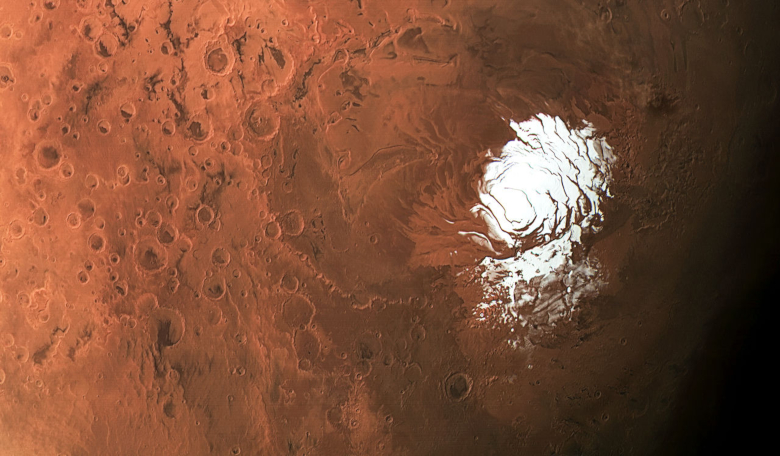Following the revelation two years ago that a pool of liquid water could be buried under the surface of Mars’ south pole, a new study that has used a different technique to study the region has discovered that its not just one subglacial lake that could be hiding, but a whole string of them – a find which could have important consequences for astrobiology.
Flying high above the Red Planet is ESA’s Mars Express spacecraft and it has been quietly observing our planetary neighbour for the past 17 years.
In July 2018, its Mars Advanced Radar for Subsurface and Ionosphere Sounding (MARIS) instrument helped scientists reinvigorate the debate about just how wet Mars might have been in its early history and how wet it might be now, when radar signals bouncing through underground layers of ice detected a particularly bright radar reflection 1.5 kilometres down that stretched for about 20 kilometres.
At the time, Roberto Orosei, principal investigator of the MARSIS experiment said that the subsurface anomaly had radar properties matching water or water-rich sediments.
Little else was surmised other than that it appeared to be a stable body of liquid water, and one that was possibly rich in salty brines.
“This is just one small study area; it is an exciting prospect to think there could be more of these underground pockets of water elsewhere, yet to be discovered,” Orosei said back in 2018.
Making good on his statement, two years later, Orosei, along with a team headed by Sebastian Emanuel Lauro at the Università degli studi Roma Tre, Italy, have done just that by discovering several subglacial liquid bodies of various sizes strewn under Mars’ South polar region.
This time around, using a technique similar to that employed by Earth satellites to detect Antarctic subglacial lakes (different to the one Orosei used previously), Lauro and colleagues scanned a much broader region – 250 × 300 km2 – around the Martian liquid body to collect more information.
After analysing the data, the authors were able to confirm the liquid nature of the previously observed lake, while also identifying several other smaller patches of water separated from the main body by strips of dry material.
“Our results strengthen the claim of the detection of a liquid water body at Ultimi Scopuli and indicate the presence of other wet areas nearby,” say the team in their research paper published today in Nature Astronomy.
Mars’ past climate is heavily debated and while some advocate it once had a warm and wet climate, others suggest that its mix of geological features are better explained if the planet underwent periods where ice dominated the landscape.
Whether the water came from melting glaciers or from flowing rivers created by downpouring rain, the team further suggest that the underground patches remain wet due to their high concentration of salts.
These hypersaline brines are known to form at Martian polar regions and are thought to survive for an extended period of time after formation without it re-crystallising, say Lauro and colleagues and could explain why such bodies can remain liquid despite the cold environment at the base of Mars’s south pole.
The team also looked at whether recent magmatic activity could be responsible for keeping the ponds liquid, but ruled this out in favour of the salt water theory, as a geothermal explanation did not fit with other key evidence obtained from planetary observations so far.
The prospect of a string of underground salty lakes is tantalising, as despite the high salinity, several forms of algae and even brine shrimp and brine flies can tolerate these conditions on Earth; although martian microbes would have significant cooler temperatures to contend with than the variety that live in salt lakes on our planet.
Despite this, could similar life have got established on Mars and managed to survive in these underground salt-laden refuges? Eriita Jones at the University of South Australia who discussed the matter in ROOM recently, suggested the shallow subsurface of Mars at least may well be habitable. Handily, there are plenty of missions hoping to find out.
“The water bodies at the base of the SPLD [south polar layered deposits] therefore represent areas of potential astrobiological interest and planetary protection concern," write the team in their paper. "Future missions to Mars should target this region to acquire experimental data in relation to the basal hydrologic system, its chemistry and traces of astrobiological activity.”











